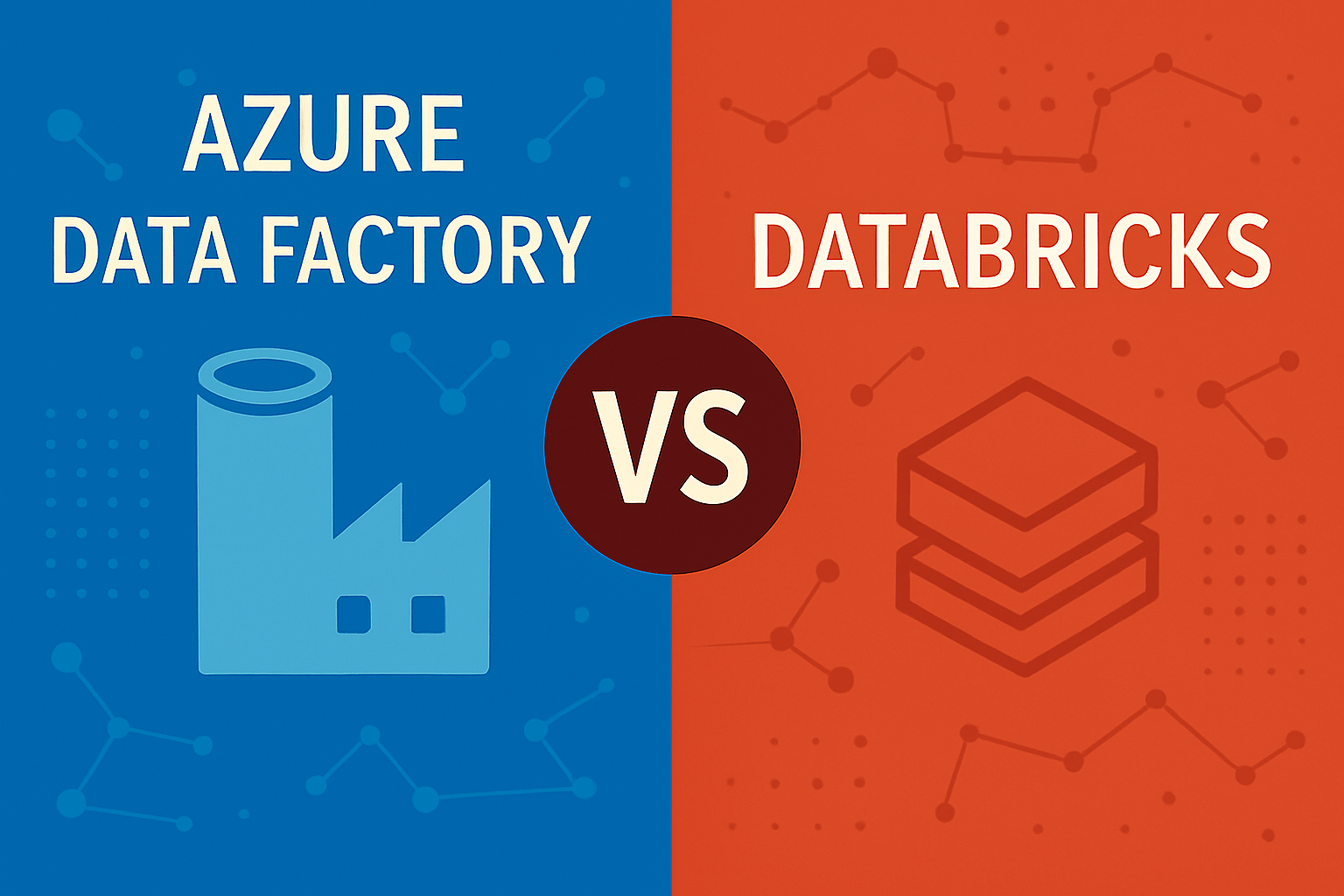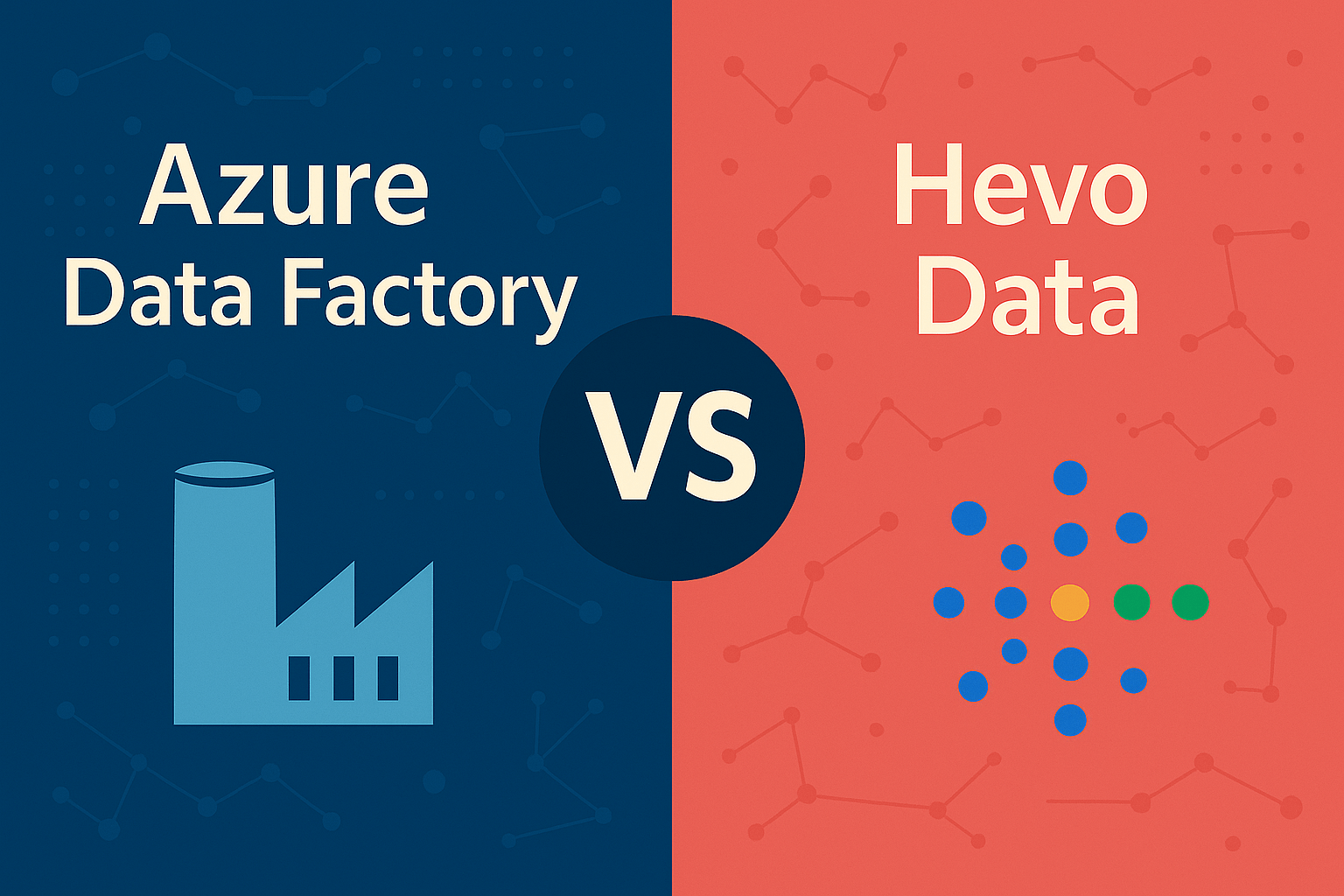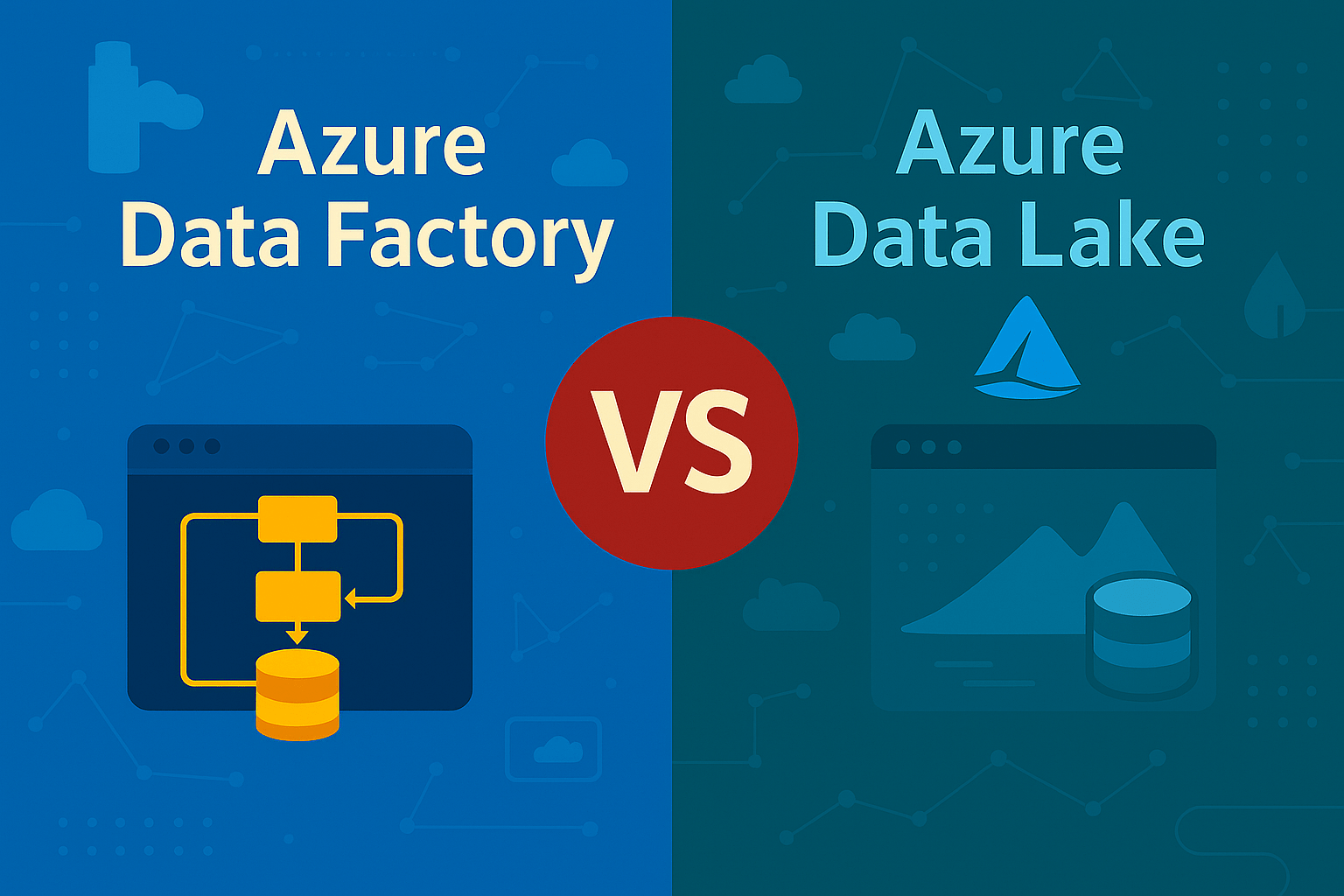Azure Data Factory vs AWS Glue: Which Cloud ETL Platform is Right for You?
Choose the Right Cloud ETL Solution for Your Data Pipeline Success
In today’s data driven world, selecting the right cloud ETL platform can significantly impact your organization’s data integration success and project outcomes. Both AWS Glue and Azure Data Factory have emerged as leading solutions, with AWS Glue used by 67% of organizations and Azure Data Factory adopted by 69% of companies worldwide.
The choice between these platforms essentially comes down to two distinct approaches: AWS Glue’s serverless, code-first methodology versus Microsoft Azure’s Azure Data Factory’s visual, low-code interface. Both Azure Data Factory and AWS Glue offer robust ETL capabilities, supporting data transformation, integration with cloud services, and automation for modern data engineering workflows. Both AWS Glue and Azure Data Factory are considered powerful tools for data engineers, offering features that cater to diverse technical needs. This comprehensive guide will help you understand which platform aligns best with your technical requirements, team expertise, and business objectives.
Whether you’re building new data pipelines or migrating existing workflows, understanding the strengths and limitations of each platform is crucial for making an informed decision that will serve your organization’s long-term data processing needs. Both services support structured data processing, enabling efficient transformation, cleaning, and aggregation in a managed, serverless environment.

What Makes These Cloud ETL Platforms Unique?
AWS Glue and Azure Data Factory have each carved out a unique space in the cloud ETL landscape, offering distinct advantages for modern data integration needs. Azure Data Factory stands out with its intuitive visual interface, allowing users to create, schedule, and manage data pipelines with minimal coding. This makes it especially appealing for organizations seeking a low-code or no-code approach to data integration, enabling faster onboarding and collaboration across technical and business teams.
On the other hand, AWS Glue delivers a fully managed, serverless data integration service that lets data engineers focus on business logic rather than infrastructure. Its serverless architecture means you don’t have to worry about provisioning or managing servers, making it ideal for organizations that want to scale data processing on demand. AWS Glue is a fully managed ETL service designed for preparing and loading data for analytics, ensuring efficient and streamlined workflows. Both platforms support a wide variety of data sources, from on-premises databases to cloud-based storage, and offer seamless integration with their respective ecosystems—Azure Data Factory with Azure Synapse Analytics and other Azure services, and AWS Glue with a broad range of AWS services.
Whether you’re managing data pipelines across hybrid environments or leveraging the power of serverless data integration, both AWS Glue and Azure Data Factory provide the flexibility and scalability needed to support today’s complex data workflows. Their ability to connect to diverse data sources and integrate with other cloud services ensures that your data integration strategy can evolve alongside your business needs.
What Makes These Cloud ETL Platform Unique?
AWS Glue – Serverless ETL Excellence
AWS Glue stands out as a fully managed etl service that embraces a serverless data integration service model with pay-per-use pricing. This serverless architecture eliminates the need for infrastructure management, allowing data engineers to focus entirely on data transformation logic rather than server provisioning or maintenance. AWS Glue is optimized for batch processing of structured and semi-structured data, making it a reliable choice for organizations with such requirements.
The platform leverages Apache Spark as its underlying processing engine, providing powerful capabilities for handling large-scale data transformations. AWS Glue supports python and other programming languages like Scala, giving developers flexibility in implementing complex data transformations. The automatic code generation feature helps accelerate development by creating initial ETL scripts based on data source schemas.
One of AWS Glue’s most valuable features is its aws glue data catalog, which serves as a central metadata repository for all your data sources. The platform’s crawlers automatically discover and catalog data across various aws services, performing automatic schema discovery that keeps your data catalog current without manual intervention. AWS Glue's data discovery capabilities enable it to automatically identify and catalog new data sources, streamlining data preparation and transformation workflows in a serverless architecture. This seamless integration with other aws services like Amazon S3, DynamoDB, and Redshift makes AWS Glue particularly powerful within the aws ecosystem. AWS Glue can also extract data from a variety of cloud sources, facilitating data ingestion for data lakes, warehouses, and analytics.
The serverless nature means you pay only for the data processing units consumed during job execution, making it cost-effective for organizations with variable or unpredictable workloads. AWS Glue is serverless, meaning you pay only for the time your ETL operations run, further enhancing its cost efficiency for dynamic workloads.
Azure Data Factory – Visual Integration Powerhouse
Azure Data Factory positions itself as a comprehensive cloud-based data integration tool that emphasizes visual development through its intuitive drag-and-drop interface. With over 90 built-in data connectors, azure data factory offers extensive connectivity options for diverse data sources, making it an excellent choice for organizations dealing with complex, multi-platform environments. Azure Data Factory can connect to and orchestrate data movement across different data stores, enabling seamless integration between various storage systems.
The platform’s visual data transformation capabilities allow both technical and non-technical users to create sophisticated data pipelines without extensive coding knowledge. This low-code/no-code approach significantly reduces development time and makes data integration accessible to a broader range of team members. Azure Data Factory also supports data driven workflows, allowing users to orchestrate, automate, and manage data movement and transformation processes efficiently.
Azure data factory integrates seamlessly with azure services like azure synapse analytics, azure sql database, and azure blob storage, while also supporting hybrid data integration scenarios. It also offers seamless integration with Azure Data Lake, enabling scalable storage and efficient data management for analytics workflows. Azure Data Factory provides enterprise-level security features built on Microsoft's security framework, ensuring robust protection for data pipelines and compliance with industry standards. The platform’s native support for importing ssis packages makes it particularly attractive for organizations migrating from microsoft sql server integration services environments.
The service supports both ETL and ELT workflows, providing flexibility in how you process data. Azure data factory charges are structured around pipeline orchestration, data movement, and data transformation activities, offering transparent pricing for different aspects of your data processing workflows.

AWS Glue vs Azure Data Factory: What’s the Difference?
Development Approach
The fundamental difference between these platforms lies in their development philosophy. AWS Glue follows a code-first approach where aws glue supports python and Scala programming languages for creating ETL jobs. While AWS Glue does offer a visual interface for basic operations, complex data transformations typically require programming skills and familiarity with Apache Spark concepts.
In contrast, azure data factory offers a comprehensive visual interface that enables creating data pipelines through drag-and-drop operations. The platform supports both .NET and Python for custom activities, but the majority of data processing tasks can be accomplished without writing code. This visual data transformation approach makes azure data factory particularly appealing for organizations with limited coding resources or those seeking rapid development cycles.
AWS Glue requires data engineers to have stronger technical expertise and coding knowledge, making it better suited for teams comfortable with programming. Azure data factory’s low-code approach enables faster onboarding and allows business analysts to participate more directly in data pipeline development. Both platforms also provide robust tools to deploy data pipelines efficiently, whether through visual interfaces, SDKs, or APIs, streamlining the transition from development to production.
Integration Capabilities
Both platforms excel in integration but serve different ecosystem needs. AWS Glue integrates seamlessly with the broader aws ecosystem, supporting JDBC-compatible data sources, Amazon RDS, Redshift, and S3 natively. The platform can connect to external data sources through custom connectors built via APIs, though this requires additional development effort.
Azure data factory offers more than 90 built-in connectors out of the box, supporting REST, OData, and HTTP protocols alongside traditional database connections. This extensive connector library includes support for various file systems, cloud services, and enterprise applications. The platform provides strong azure services integration while maintaining excellent connectivity to external platforms and hybrid environments.
For organizations heavily invested in AWS infrastructure, AWS Glue’s deep integration with other aws services provides significant advantages. However, azure data factory’s broader connector ecosystem makes it more suitable for complex, multi-cloud, or hybrid data integration scenarios.
Pricing Models
Understanding the cost structure is crucial for budgeting your data integration projects. AWS Glue uses a straightforward pay-as-you-go model, charging $0.44 per data processing unit (DPU) per hour. Each DPU provides 4 vCPUs and 16 GB of memory. The service includes 1 million free data catalog objects monthly, making it cost-effective for smaller catalogs.
Azure data factory employs a more complex pricing structure at $0.25 per unit, plus additional costs for pipeline runtime, data movement, and transformation activities. Azure Data Factory's pricing structure involves costs for pipeline execution, data reads/writes, and integration runtime hours. New users receive $200 in free credits, allowing them to explore the platform’s capabilities before committing to regular usage.
AWS Glue’s pricing model is more predictable for compute-intensive workloads, while azure data factory charges can vary significantly based on pipeline complexity and data movement requirements. Azure Data Factory operates on a pay-as-you-go pricing model for its services, allowing organizations to scale costs based on actual usage. Organizations should carefully model their expected usage patterns when comparing costs between these platforms.
Security and Compliance Considerations
Security and compliance are at the forefront of any data integration strategy, especially when handling sensitive customer data. Azure Data Factory offers enterprise-grade security, including robust data encryption both at rest and in transit, granular access controls, and compliance with major regulatory standards such as GDPR, HIPAA, and SOC 1/2. Azure Data Factory provides integrated monitoring within the Azure Portal for improved pipeline traceability and management, ensuring that your azure data and data pipelines are protected throughout their lifecycle.
AWS Glue also prioritizes security, providing strong data encryption, fine-grained access controls, and compliance with standards like PCI DSS and HIPAA. The AWS Glue Data Catalog acts as a central metadata repository, helping organizations manage and govern their data assets efficiently. Both AWS Glue and Azure Data Factory enable secure data processing and movement, giving organizations confidence that their customer data is handled in accordance with industry best practices.
By leveraging the security features and compliance certifications of both platforms, organizations can ensure that their data integration processes meet stringent regulatory requirements while maintaining the integrity and confidentiality of their data assets.
Change Data Capture and Real-Time ETL
For organizations that require real-time insights and up-to-date analytics, both AWS Glue and Azure Data Factory offer robust support for Change Data Capture (CDC) and real-time ETL. AWS Glue integrates with AWS Database Migration Service (DMS) to enable CDC, allowing you to capture and process changes from your data sources as they happen. AWS Glue automatically discovers and profiles your data to generate ETL code, streamlining the development process and ensuring efficient data preparation. This is particularly valuable for keeping data warehouses and analytics platforms in sync with operational databases.
Azure Data Factory provides comprehensive real-time data integration capabilities, supporting streaming data sources and sinks, and integrating seamlessly with Azure services like Azure Stream Analytics and Azure Functions. This enables organizations to build data pipelines that process and transform streaming data in real time, supporting use cases such as real-time dashboards, monitoring, and alerting.
Both platforms offer a wide range of data connectors, making it easy to connect to relational databases, NoSQL stores, file systems, and more. Their visual data transformation tools further simplify the process of designing and managing real-time data flows, ensuring that your data integration architecture can keep pace with the demands of modern business.
Developer Tools and Support Ecosystem
A strong developer ecosystem is essential for building, deploying, and managing data pipelines efficiently. Azure Data Factory provides a user-friendly visual interface for designing data pipelines, along with support for popular programming languages like Python, .NET, and SQL. This flexibility allows data engineers to choose the best tools for their workflows, whether they prefer a visual or code-based approach.
AWS Glue supports Python and Scala, offering a rich set of libraries and frameworks for data transformation and processing. The platform’s support for programmatic development makes it a favorite among data engineers who want granular control over their ETL jobs. Both AWS Glue and Azure Data Factory offer comprehensive APIs, SDKs, and integration with other services—such as Azure Blob Storage and a wide array of AWS services—enabling seamless data movement and transformation across your cloud environment.
In addition to robust tooling, both platforms benefit from active developer communities, extensive documentation, and a wealth of tutorials and forums. This strong support ecosystem empowers data engineers to manage data pipelines effectively, troubleshoot issues quickly, and stay up to date with the latest best practices in data integration.
Whether you’re building complex data transformations, managing data pipelines at scale, or integrating with other cloud services, both AWS Glue and Azure Data Factory provide the developer tools and community support needed to drive successful data integration projects.
What Data Engineers Say
Data engineers working with AWS Glue consistently praise its serverless architecture and automatic scaling capabilities. “The fact that I don’t need to manage infrastructure while still having full control over my data transformations is game-changing,” notes a senior data engineer at a Fortune 500 company. Users particularly appreciate the deep aws ecosystem integration and the platform’s ability to handle large-scale batch processing efficiently.
Azure data factory users frequently highlight the platform’s visual interface and extensive connector ecosystem. “Being able to create complex data pipelines without writing code has dramatically reduced our development time,” explains a data architect at a global consulting firm. The platform’s support for importing ssis packages has proven invaluable for organizations migrating from on-premises Microsoft environments.
The learning curve differences between platforms are notable. AWS Glue typically requires 2-3 weeks for experienced developers to become productive, while azure data factory’s visual interface allows users to create basic pipelines within days. However, both platforms require solid understanding of ETL concepts and data integration best practices for optimal results.
Team productivity impacts vary based on existing skills. Organizations with strong Python or Scala expertise often achieve faster results with AWS Glue, while teams with diverse technical backgrounds tend to be more productive with azure data factory’s visual approach.

Implementation Requirements Overview
Successfully implementing AWS Glue requires your team to have solid Python or Scala coding skills, along with understanding of AWS services architecture and Apache Spark fundamentals. Data engineers should be comfortable with serverless concepts and familiar with aws glue data catalog management. The platform works best when teams can leverage existing AWS infrastructure and have experience with other aws services.
Azure data factory implementation requires minimal coding skills for basic operations, though Azure ecosystem familiarity is helpful for advanced scenarios. Teams benefit from understanding azure services integration patterns and experience with visual workflow design. The platform’s strength lies in accommodating teams with varying technical skill levels while maintaining powerful data processing capabilities.
Both platforms require solid understanding of ETL concepts, data integration best practices, and data pipeline design principles. Organizations should consider their existing cloud infrastructure investments, team expertise levels, and long-term data strategy when planning implementation approaches.
Successful deployments also depend on proper data governance frameworks, security protocols for secure data movement, and monitoring strategies for managing data pipelines effectively. Additionally, both AWS Glue and Azure Data Factory can be integrated with machine learning workflows to enhance data preparation, transformation, and analytics capabilities.
Which Cloud ETL Platform is Right for You?
Choose AWS Glue if you need:
AWS Glue is the ideal choice for organizations seeking a serverless data integration service with deep aws ecosystem integration. If your team has strong coding skills in Python or Scala and prefers code-based control over complex data transformations, AWS Glue provides the flexibility and power you need.
The platform excels for organizations already invested in the AWS infrastructure, particularly those using services like Amazon S3, Redshift, or RDS. AWS Glue’s automatic scaling and pay-per-use pricing model make it excellent for workloads with variable demands or cost-conscious organizations that want to avoid infrastructure overhead.
Choose AWS Glue when you need advanced Spark-based processing capabilities for large-scale data transformations, or when your data engineering team prefers programmatic control over ETL processes. The platform’s fully managed etl service approach eliminates infrastructure management while maintaining processing flexibility.
Choose Azure Data Factory if you need:
Azure data factory is perfect for organizations requiring a visual, low-code ETL development environment that accelerates pipeline creation and reduces technical barriers. If your team includes members with varying technical skill levels or you need rapid development cycles, the platform’s visual interface provides significant advantages.
The extensive pre-built connector ecosystem makes azure data factory ideal for complex, multi-cloud, or hybrid data integration scenarios. Organizations migrating from microsoft sql server integration services will find the SSIS package support invaluable for gradual migration strategies.
Select azure data factory when you need comprehensive azure services integration combined with external platform connectivity. The platform’s hybrid data integration capabilities and support for both structured and unstructured data processing make it suitable for diverse enterprise environments.
The visual data transformation capabilities and extensive data connectors position azure data factory as the better choice for organizations prioritizing rapid development, broad connectivity, and accessibility across technical skill levels.
Both aws glue and azure data factory offer powerful capabilities for modern data integration needs. Your choice should align with your team’s technical expertise, existing cloud infrastructure, and specific data processing requirements. The choice between Azure Data Factory and AWS Glue often hinges on existing cloud ecosystem investments, as each platform integrates deeply with its respective cloud services. Consider conducting pilot projects with both platforms to evaluate which approach better serves your organization’s long-term data strategy.
Built for the Plant Floor: Factory Thread vs Azure Data Factory vs AWS Glue
Azure Data Factory and AWS Glue handle structured cloud data pipelines well. Factory Thread goes further—bridging the gap between cloud ETL and real-time, governed access to operational systems like MES, ERP, and SCADA. For more options, see our guide on alternatives to Snowflake.
Why manufacturers choose Factory Thread:
-
No-code access to OT/IT systems – Empower engineers and analysts to extract and transform live shop floor data
-
Built-in governance – Role-based permissions, auditing, and policy control built for compliance
-
Works anywhere – Air-gapped edge deployments, hybrid cloud, or SaaS—without sacrificing control
-
Faster insights – Automate secure data access for dashboards, AI models, or cross-plant analytics
Factory Thread is not just another ETL tool—it's a manufacturing-grade data platform designed for industrial complexity.
Share this
You May Also Like
These Related Stories

Azure Data Factory vs. Databricks: Which Data Platform is Right for Your Analytics Needs?

Azure Data Factory vs Hevo Data: Which Data Integration Platform is Right for You?



No Comments Yet
Let us know what you think